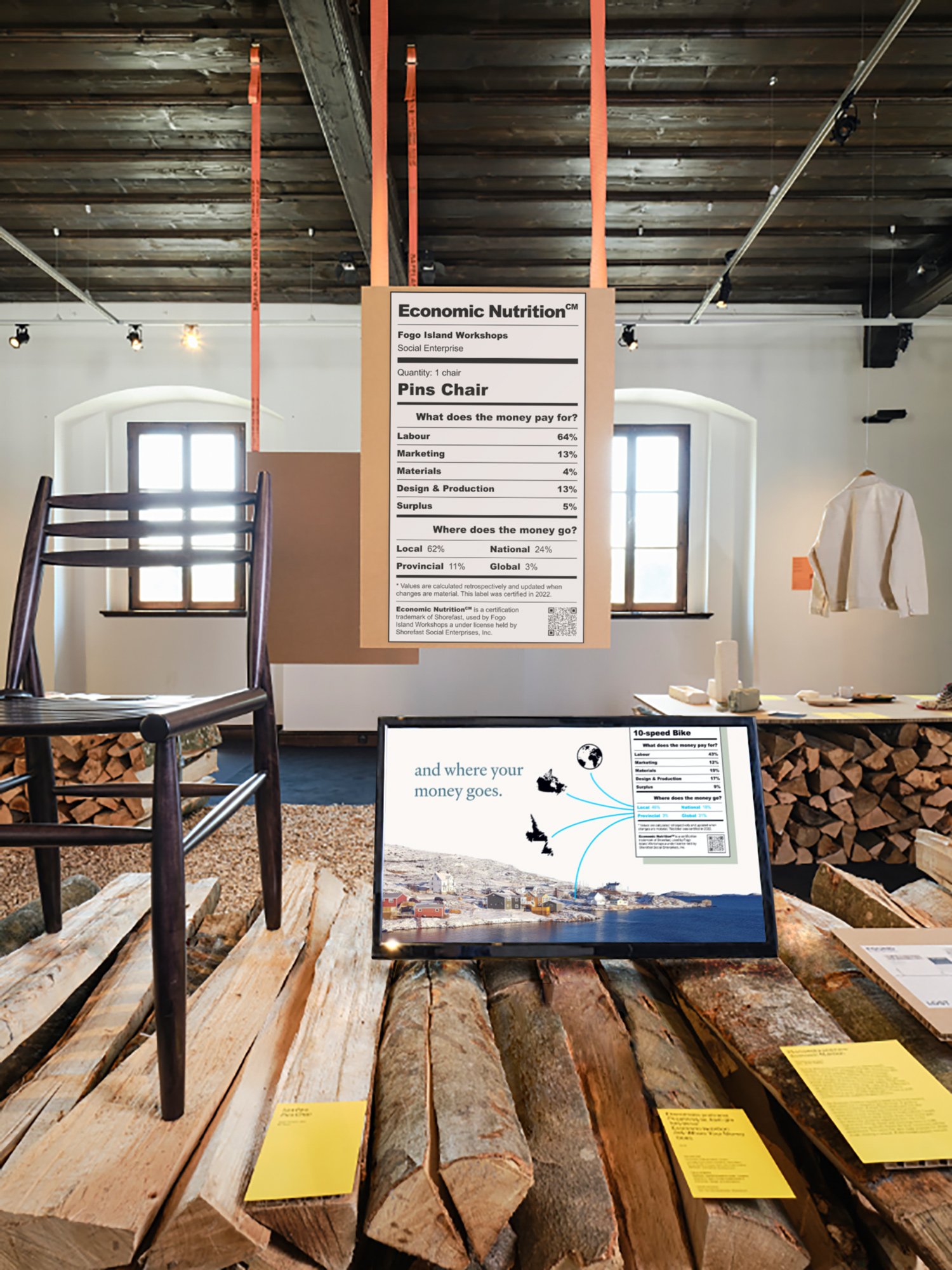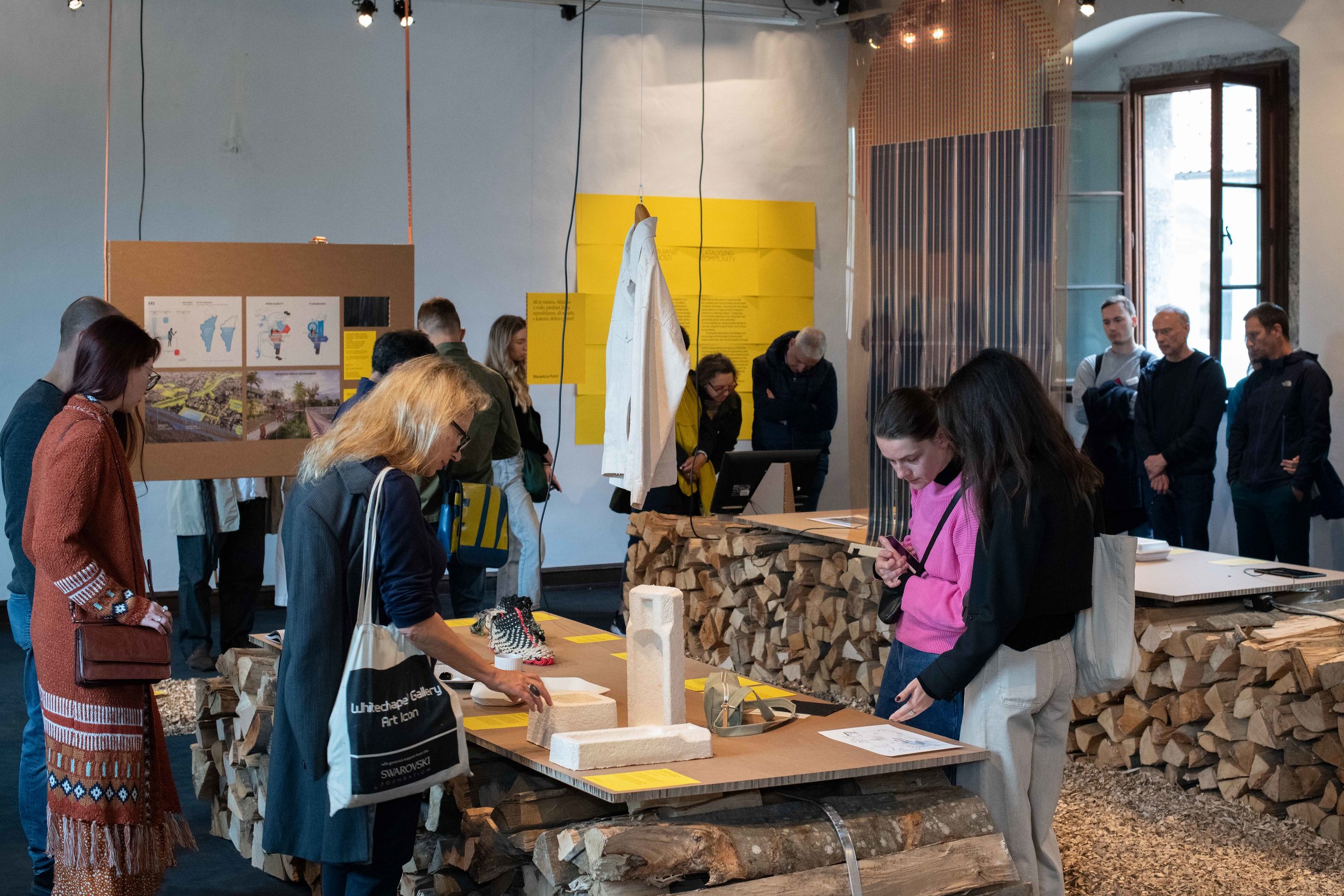
Prototyping Economic
Transparency
(4 min read)
A tool for rewiring the global economy in support of local communities—from vision to message to action.
Shorefast created the Economic Nutrition label to reveal the financial impact of any product—showing consumers what their money pays for and where their money goes. Field States worked closely with their team to explore the future of Economic Nutrition, and bring it to life. Starting with a business model analysis and strategic roadmap, we gave structure and momentum to the initiative, designing communications tools (brand identity, video, website) and a pilot project.
“Economic Nutrition has big implications for businesses, communities, economics, and politics. Field States brought clarity and creativity to the process of exploring how to best deploy our ideas in new ways.”

Zita Cobb
Co-founder & CEO,
Shorefast
For twenty years, Zita Cobb and the team at Shorefast—a Canadian charitable organization—worked to transform Fogo Island into a tightly-knit community economy. As people, businesses and the landscape were woven together, it became possible to map the invisible web of economic and social connections.
Zita and her colleague Diane Hodgins conceived of a simple, clear way to reveal the economic effects behind every purchase. The label—modeled after nutrition facts on food—broke down what the price of a product pays for (labor, marketing, materials, a local business or an international supplier). It could be used on any product, and showed consumers the impact of their dollar, empowering them to make choices in support of local communities and sustainable practices.
The team gathered data for local products and services within their portfolio of companies. They used the idea to help tell the story of Shorefast and the island. The labels appeared on their website, and people found the concept intriguing—but the initiative was stalling. Shorefast wanted this to become something more—a certification mark and standard for every product, with the potential to rewire the global economy in service of place.
A frame from our explainer animation for Economic Nutrition
Shorefast hired Field States to explore the future of Economic Nutrition, and help bring it to life. The design brief was broad, so our first step was to sharpen it into three guiding questions:
Field States studied dozens of standards, certifications and labels. Our research took us from B Corps to organic agriculture, to the religious history and certifier economy around Kosher food.
Patterns began to emerge: we discovered three fundamental architectures for certification systems—each with its own business model, validation system, service providers, and maintenance protocol. This enabled us to map the landscape of operational functions, staffing requirements, users, partners, revenues and costs, and potential for impact. Having gotten to the heart of how such labels really work, we formed a hypothesis about how Shorefast's Economic Nutrition label could be effective.
for certification systems—each with its own business model, validation system, service providers, and maintenance protocol. This enabled us to map the landscape of operational functions, staffing requirements, users, partners, revenues and costs, and potential for impact. Having gotten to the heart of how such labels really work, we formed a hypothesis about how Shorefast's Economic Nutrition label could be effective.
We analyzed Shorefast’s organizational strengths, capacities, and public identity. What Shorefast couldn’t do itself, it could achieve through partnership—we researched potential partners and presented a complementarity map that identified key partner types. The first phase concluded with a strategic recommendation, including a system architecture, staffing and roles, revenue model, users, key partners, and a growth path.
that identified key partner types. The first phase concluded with a strategic recommendation, including a system architecture, staffing and roles, revenue model, users, key partners, and a growth path.
With one question answered and a hypothesis about a second, we set out to see if the EN concept makes sense to the public. To do that, we needed to create a holistic visual system.
Rewiring the economy through price transparency is an ambitious concept that requires clarity and punch.
The label wouldn’t survive as a dry financial disclosure standard—it needed to become a movement. We worked with Zita, Diane, and their team to refine years of financial modeling and deep thinking into a compelling, actionable narrative.
We reworked the label’s messaging and visual structure to clarify the concept: knowing what your money pays for and where your money goes, while streamlining and strengthening its design.
Field States created a full brand and design system for the Economic Nutrition Initiative. We wanted it to fit well with Shorefast’s established visual language, while remaining distinct and recognizable. Color and type stayed simple, echoing the clarity of the food nutrition label. Stories of vibrant local economies, especially Fogo Island, were incorporated through photography.
We wrote, styled, and animated a video to tell the story (see above), and launched the beginnings of a new site. Our work was featured at the BIO27 international design fair in Ljubljana—in a larger setup designed by Anniina Koivu. The project drew the interest of the curious and connected audience of designers, social thinkers, and craftspeople.


With a message and visual communication material in place, the label was ready for a wider audience. We devised a pilot program to understand if and how the concept resonates with people.
Working closely with Shorefast and key partners on Fogo Island, we planned and supported an implementation at Growlers Ice Cream shop. We created a training protocol for the shop staff, a multi-modal (digital/physical) question framework for customers, and an evaluation model for the pilot as a whole. We designed the visitor experience, including supporting artifacts like brochures and instructions.
For part of the summer of 2022, visitors buying an ice cream at Growlers could see what their money pays for and where their money goes—a story of local ingredients and community-oriented entrepreneurship.
The pilot was successful. Staff at the shop saw value in using the system, and felt prepared to answer visitors’ questions. In the words of one staff member, “I think this will do great in Growlers, especially for people who want to know where their money is exactly going when they buy from our store.”
Visitors found the label understandable, and confirmed that, if widely implemented, it could shift their consumption patterns. Interviewees used versions of the language we developed for the initiative (e.g. “know where your money goes”)—a sticky message.
One finding surprised us: several people suggested big box retail as a place they’d like to see the label—in addition to more expected answers, like grocery stores.
Fogo Island is a unique community, so testing Economic Nutrition outside of it will provide valuable insight. After the initial pilot, Shorefast is positioned to launch the program with a cohort of small businesses across Canada. A broader launch will enable us to observe how the narrative resonates, if the financial modeling framework is feasible, and how the staff members of small businesses absorb the operational processes of an implementation. Most importantly, a bigger pilot will reveal the label’s impact on consumer behavior.
Zita, Diane, and the Shorefast team have created a fundamentally new way to understand the power of economic connections. Economic Nutrition stands to inform consumer behavior, supporting the transformation of places into community economies—and we’re honored to be part of that story.

